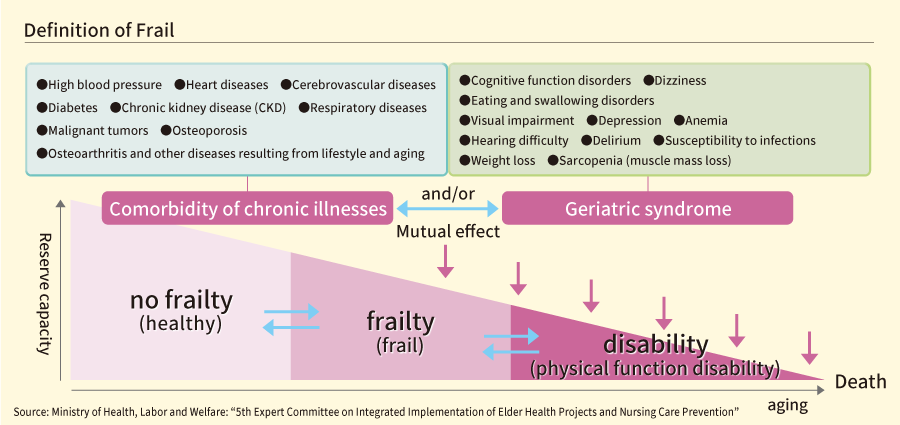
What is Needed to Expand Business in Japan’s Senior Market? Part 1: Gaining a Detailed Understanding of and Appealing to Seniors’ Needs
In Japan, the senior market is expanding along with the aging of society. Meanwhile, many companies seem unable to narrow down their targets and those targets’ needs. In Volume 42 of the “NRI Management Review”, Marie Takahashi, Miki Shitamatsu, Maiko Takiguchi, and Satomi Tsunoo of NRI wrote about expanding business in the senior market using their individual expertise and experience. We brought them together to discuss why companies are struggling and what perspectives are needed.
Why is it difficult to capture the senior market?
Takiguchi: I feel that in many cases companies that haven’t viewed seniors as a market tend to lump all seniors into the same category. But even just looking at the aspect of health state, seniors are very diverse. The reality can’t be grasped without taking a closer look. For instance, even just dividing seniors into age groups by decade, the characteristics of the image of seniors in each group are very different.

Shitamatsu: I believe one reason that companies haven’t done analyses in detail is that they took a negative view of seniors as “a group that has stepped down” or “a group with obvious physical decline”, and not as a leading force driving consumer activity. It was considered taboo to dig too deeply into that mindset. The effect of the nursing care insurance system and other regulations are also conceivable reasons. Companies’ main purpose came to be acquiring nursing care insurance points or conforming to rules, and examining the needs of seniors tended not to be given high priority.
Tsunoo: Seniors of the past may have mostly been blessed with plentiful time and money, but now that the retirement age has been raised, many may not have so much free time after all. Since people’s daily lives differ depending on whether or not they are working, even at the same age of 60 or 65, it is necessary to suggest products and services suitable for each group. Another perspective is to look not just at age, but at whether a person is active or not.
Takahashi: I also want to focus on the fact that even in the same age group, there are differences between generations. For example, the “NRI Questionnaire Survey of 10,000 Consumers” carried out regularly by NRI since 1997 has shown us that people in their 50s now (pre-seniors), who were young in the bubble era, have strong brand preference compared to people who were in their 50s ten years ago (now in their 60s). The rate of men who have fully paid off their mortgages is lower than in previous generations, and these men have less money to spend freely, so the way they enjoy consumption is by avidly gathering information to inform their choices. If a company wants to target this group, they need to increase the strength of their brand by disseminating information, and they must also take care in the tools they use to appeal to the market. TV advertisements may have been effective with older generations, but current pre-seniors make more use of review websites and SNS on their smartphones.
What methods are effective in appealing to seniors?
Takahashi: I sense that many companies are struggling with promotion strategies. That’s because seniors won’t buy products that are branded as “products for seniors”.
Tsunoo: For seniors who are still healthy and active, a message like “How about giving senior yoga a try?” would make the product seem much more enjoyable than one like, “You will find it challenging to move your body soon, so you should do nursing care exercises for prevention.” The former preserves their dignity and will surely be better received.
Takiguchi: It’s important to avoid messages of “overcoming the negative aspects of daily life” with respect to seniors and instead appeal to them by describing the benefits they will get in scenarios in their ordinary life. That being said, it’s not easy for companies that have little experience with the senior market to grasp seniors’ needs. In my essay on this topic, I introduce the method of creating a needs map; I recommend coming up with an image of seniors while considering “what daily life scenarios would suit a person in this kind of state?”
Shitamatsu: In the field of nursing care prevention, which I discussed, public and private business chances rapidly expand when laws are revised or when new policies are launched. It’s important to have a good understanding of information relating to such systems and policies and use them skillfully when entering the senior market.
The potential of marketing using “keywords”
Shitamatsu: From the perspective of nursing care prevention, once someone requires nursing care it’s difficult to return to a state of health, but at the stage of “frail”, where a person is in a frail state but not quite yet in need of nursing care, appropriate intervention can allow the person to return to a state of health or maintain a condition that doesn’t require nursing care. Being frail is the result not just of physical deterioration, but also of a reduction in social involvement. For example, in the field of beauty, “frail” starts when one stops being concerned about one’s physical appearance. If a company focuses on that, they become able to conceive of new services from a slightly different perspective, such as makeup therapies that encourage people to get dressed up and renew their desire to go out.

Takahashi: When it comes to food products, marketing activities are facilitated by clearly demarcating segments, explaining that a product is “effective for elders in a frail state”, rather than vague appeals that a product is “good for health”. By extracting the segment “frail”, even companies that were unable to produce results in the field of nursing care might be able to produce results more easily.

Tsunoo: “Wellness” is another important keyword meaning being in good health physically, mentally, and socially. “Wellness” products have generally been thought to target people who are highly sensitive to new things, such as businesspeople and millennials, but I think it’s also possible to include the senior market here. For instance, we are seeing the emergence of products like alternative meat and alternative mayonnaise made from plant ingredients based on the expansion of vegan (strict vegetarian) philosophy, concern for environmental issues, and the like, and seniors with diabetes or other food restrictions can enjoy these foods with peace of mind.
Takiguchi: “Wellness” is a keyword that we want to see used as part of work style reforms, and I think it is a market that will grow over the next ten to twenty years. I think there is leeway to skillfully develop this market for seniors as well.
What is Needed to Expand Business in the Senior Market? Part 2
Profile
-
Marie Takahashi
-
Miki Shitamatsu
-
Maiko Takiguchi
-
Satomi Tsunoo
* Organization names and job titles may differ from the current version.